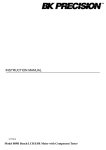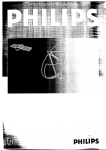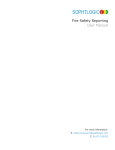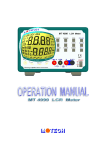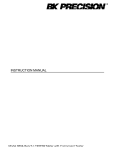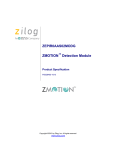Download Procedure for LET Comprehensive Performance Test Doc. No
Transcript
Procedure for LET Comprehensive Performance Test Doc. No. STEREO-CIT-026.B Record: Local date __________, Local time __________, (FM1, S/C A) ______, (FM2, S/C B) ______, UTC date ________, UTC time ________, Initials ______, Temperature ______ ºC, Rel. humidity ______ %. List SEP sensors attached: LET _____, HET _____, SIT _____, SEPT-E _____ and SEPT-NS _____. Describe test set-up configuration: _____________________________________________________________ __________________________________________________________________________________________ __________________________________________________________________________________________ __________________________________________________________________________________________ 1.0 INTRODUCTION 1.1 TEST NAME: LET Comprehensive Performance Test 1.2 RESPONSIBLE SUBSYSTEM/INSTRUMENT LEAD: Branislav Kecman 1.3 AUTHOR: Branislav Kecman (626) 395-4264, [email protected] 1.4 DATE CREATED: Rev A Rev B October 4, 2004 January 19, 2005 April 4, 2005 Checksum update and edit Checksum update and edit 2.0 DESCRIPTION 2.1 PROCEDURE DESCRIPTION: The procedure verifies comprehensive performance of the Low Energy Telescope (LET) sensor as part of Solar Energetic Particles (SEP) instrument suite before and after the following activities: SEP bench and environmental tests, SEP integration with the IMPACT suite, IMPACT suite integration with the STEREO spacecraft, S/C environmental tests, pre-launch operations and in flight. It exercises many aspects of LET operational modes and provides reliable means for their tracking over relatively long time period implied above. 2.2 PROCEDURE OUTLINE AND DOCUMENT REFERENCE NUMBER: 2.2.1 SEP Power On STEREO-CIT-031.A 2.2.2 SEP_Central Aliveness Test STEREO-CIT-034.A 2.2.3 Normal Mode (LET Aliveness Test) STEREO-CIT-024.A 2.2.4 ADC Only Mode * 2.2.5 Quiet Mode * 2.2.6 Threshold Mode * 2.2.7 LET Heater Mode * 2.2.8 SEP Power Off STEREO-CIT-032.A 2.3 TEST DURATION: 1 hour (maximum expected time). Page 1 Procedure for LET Comprehensive Performance Test Doc. No. STEREO-CIT-026.B 3.0 INSTRUCTIONS FOR USE - Obtain a double-sided hard copy of this procedure for record keeping during the test. - Refer to SEP GSE User’s Manual on how to log in and set up GSE computers and run GSE software. - In this procedure all displays for data verification are based on a Linux PC, either desktop or laptop, which is commonly referred to as SEP GSE. - To command LET go to SEP Command Center window on SEP GSE. Select ASCII Command option and enable LET-CMD button. Type LET command in CAPITAL letters. Verify spelling before hitting the RETURN key. - Verify checksums and command responses in SEP Command Echo Monitor window on SEP GSE. - Monitor LET operation on GSE displays as instructed by the procedure. 3.1 TEST SETUP REQUIREMENTS: LET shall be installed on its bracket atop SEP Central Electronics box and set up on one of the following: environmental test fixture, clean flow-bench or STEREO spacecraft. LET data shall go to SEP GSE either directly or via IMPACT GSE. Both GSEs shall be in their monitoring mode and mutually communicating before the test begins. Boil-off LN2 purge shall be continuously supplied to LET except during T/V test. Monitor flow daily. LET sensor shall be double-bagged in llumalloy bagging material before being taken out of cleanroom. 3.2 PARAMETERS REQUIRED: In order to test LET operational heater at any given temperature the heater control parameter (Set Point) needs to be adjusted so that ambient temperature appears cold enough for the controller to start the heating. This parameter is featured in Section 2.2.7. 3.3 CRITICAL ACTIVITIES: DO NOT send commands until LET representative conducting the procedure gives verbal OK. In vacuum DO NOT power on SEP within the first 24 hours of reaching stable pressure of 10-6 torr. In case of a vacuum loss LET power shall be immediately shut off via automatic relay. 3.4 SPECIAL CONSTRAINTS OR ACTIVITIES: LET apertures shall be protected by their red tag covers at all times except during environmental tests. DO NOT touch exposed aperture windows and make sure nothing accidentally hits them while the covers are removed. LET sensor weighs 0.85kg and sits on top of SEP Main Assembly which makes it top-heavy. Special care must be taken during stand-alone testing to firmly attach SEP Main Assembly to the mounting surface in order to prevent accidental tipping. 3.5 RECORDING REQUIREMENTS: Prior to the execution of this procedure SEP GSE software shall be running, data logging enabled and pertinent LET data windows and displays open on SEP GSE. Test conductor shall follow the procedure steps and fill in the blanks on a hard copy of this procedure and snap GSE display windows as instructed by the procedure. Hard copies shall be filed in the CPT section of a three-ring binder titled “LET Functional Tests”. LET data shall be stored on SEP GSE and backed up immediately on another Linux PC. Page 2 Procedure for LET Comprehensive Performance Test Doc. No. STEREO-CIT-026.B 4.0 SAFETY 4.1 HAZARDS OR WARNINGS: Hazard: Some sections of this procedure involve use of approved radiation sources that shall be handled by authorized LET team personnel. Post signs to that effect in the test area to limit access. Warning: Although high voltage lines are NOT exposed, various bias voltage lines inside LET can reach up to +250VDC. 5.0 DATA ANALYSIS 5.1 TEST MEASUREMENTS: LET measurements are made internally and displayed on SEP GSE for data analysis by LET team. SEP GSE and off-line computers shall be used to verify LET performance characteristics. 5.2 APPROVAL PROCESS: Discrepancies between expected and measured results shall be highlighted on the hard copy and brought to the attention of the responsible person(s) listed in Section 1.2 for eventual approval or disposition by the LET team. 6.0 REFERENCE MATERIAL 6.1 REFERENCE DOCUMENTS: 6.1.1 SEP GSE User’s Guide 6.1.2 Test procedures listed in Section 2.2 (If document no. or * is shown that means its executive portion is folded in the main procedure below) 6.1.3 SEP GSE display snapshots used for LET functional test comparison purposes 6.2 REFERENCE DRAWINGS: None. ########################################################################################## Some examples of typical record keeping required in this procedure: ______ UTC Record UTC time on this line if available in the procedure step. UTC time can be found on SEP GSE computer in the lower right corner. Make sure to compare and synchronize personal watches with UTC time. Verify that command echo was received on SEP GSE. ____ (√ echo) Type command as shown below (but without SEP> prompt) and record instrument response on the line provided. Compare the response with the expected value given in parentheses: SEP> HERE . (Note there is a space between E and the dot) _______ (20024) ########################################################################################## Page 3 Procedure for LET Comprehensive Performance Test Doc. No. STEREO-CIT-026.B BEGINNIG OF EXECUTIVE PORTION ______ UTC 2.2.1 SEP Power On STEREO-CIT-031.A If SEP power is on and LET has already booted, skip this procedure and go directly to 2.2.3. ____ (√ if so) ______ UTC 1a. Be sure that either lab P/S or IMPACT GSE or S/C power is properly connected to SEP. Click on the preferred dice icon (FM1, S/C Ahead) ____ or (FM2, S/C Behind) ____ on SEP GSE to start the corresponding software and establish proper data recording channel on GSE. Enable data logging ____ (√ if OK), open all SEP GSE displays/windows of interest ____ (√ if OK) and get ready to synchronize switching of SEP power and enabling of IDPU I/F clock within 5 seconds after power is turned on in order to capture SEP Central boot checksums. ____ (√ if OK and ready to continue) ______ UTC 1b. Verify SEP Central checksums after booting (10-15 seconds following the power on). On SEP Central FM1 unit verify these: B0B ____ 1018 ____ 93831D ____ (√ if OK) 1582 ____ 1918 ____ 51400A ____ 191D ____ 1A37 ____ 9019 ____ 2412 ____ 4E38 ____ F6EF2 ____ RAM F4C232 ____ PROM0 F52F4B ____ PROM1 F52F4B ____ BOTH EA5E96 ____ On SEP Central FM2 unit verify these: B0B ____ 1018 ____ 1582 ____ 1918 ____ 191D ____ 1A37 ____ 2412 ____ 4E38 ____ RAM F4C232 ____ PROM0 425E6F ____ PROM1 1923DA ____ BOTH 5B8249 ____ 93831D 51400A 9019 F6EF2 ____ ____ ____ ____ (√ if OK) ______ UTC 1c. Verify SEP main +28V supply current _______ A (It can vary depending on how many SEP sensors are attached to SEP Central: for LET alone 0.188A, for LET/HET FM1 0.196A, for LET/HET FM2 0.191A, for complete SEP 0.252A. If operating at cold, the operational heaters will turn on/off periodically and draw a predictable amount of extra current. If SEPT is attached, its operational heaters will cycle on/off until Step 1f is executed.) ______ UTC 1d. Verify SEP main +28V supply voltage _______ V (28V) 1e. The following command returns address at the end of FORTH dictionary in SEP Central memory: ______ UTC SEP> HERE . (Note there is a space between E and the dot) _______ (20024) Page 4 Procedure for LET Comprehensive Performance Test Doc. No. STEREO-CIT-026.B 1f. The following command turns on bias voltages, enables SEPT PDFE circuits and SEPT operational heater control, and boots SIT, HET and LET sensors in that order. Command responses consist of boot messages and checksums. It takes about 60 seconds to execute if all four sensors are attached: ______ UTC SEP> ALLON1 (for FM1, S/C A) ____ or SEP> ALLON2 (for FM2, S/C B) ____ (√ echo) Verify that SIT has booted and SIT> prompt was shown ____ (√ if OK) Verify that HET has booted and HET> prompt was shown ____ (√ if OK) Verify that LET has booted and LET> prompt was shown ____ (√ if OK) ______ UTC 1g. After LET has booted verify SEP main +28V supply current _______ A (It can vary depending on how many SEP sensors are attached to SEP Central: for LET alone 0.215A, for LET/HET FM1 0.228A, for LET/HET FM2 0.226A, for complete SEP 0.307A. If operating at cold, the operational heaters will turn on/off periodically and draw a predictable amount of extra current.) ______ UTC 1h. Verify LET checksums. On LET FM1 unit verify these: AF3 ____ 1000 ____ 9197FF ____ 10FC ____ 12DC ____ 990383 ____ 12E6 ____ 23FC ____ E2FAC3 ____ 4876 ____ 937F ____ F5487F ____ 937F ____ B428 ____ 1ABF06 ____ 1D9DCA ____ On LET FM2 unit verify these: AF3 ____ 1000 ____ 10FC ____ 12DC ____ 12E6 ____ 23FC ____ 4876 ____ 937F ____ 937F ____ B428 ____ 1D88D4 ____ 9197FF 990383 E2E5CD F5487F 1ABF06 1i. The following command sets various firmware flags in their proper state: ______ UTC SEP> INITRCHK (√ if OK) ____ ____ ____ ____ ____ (√ if OK) ____ (√ echo) ______ UTC 1j. If there are no anomalies above, SEP Power On procedure is complete. Record its total running time and any observations or anomalies here: _________________________________ __________________________________________________________________________________________ __________________________________________________________________________________________ __________________________________________________________________________________________ Page 5 Procedure for LET Comprehensive Performance Test ______ UTC Doc. No. STEREO-CIT-026.B 2.2.2 SEP_Central Aliveness Test 2a. Open all SEP displays on SEP GSE. STEREO-CIT-034.A ____ (√ if OK and ready to continue) ______ UTC 2b. Verify SEP main +28V supply current _______ A (It can vary depending on how many SEP sensors are attached to SEP Central: for LET alone 0.215A, for LET/HET FM1 0.228A, for LET/HET FM2 0.226A, for complete SEP 0.307A. If operating at cold, the operational heaters will turn on/off periodically and draw a predictable amount of extra current.) ______ UTC 2c. Verify SEP main +28V supply voltage _______ V (28V) 2d. The following command returns elapsed time in hours/minutes/seconds/sub-seconds since the last booting. ______ UTC SEP> TIME. (Note there is no space between E and the dot) ______________ (record) 2e. Verify that SEP Central section of SEP Housekeeping display (bottom portion) has no indication of yellow/red limit violations for voltages and temperatures monitored. ____ (√ if OK) Record SEP Central HK anomalies here: ________________________________________________________ 2f. Verify that two bias voltage monitors are showing approx. –120V and +330V. ____ (√ if OK) 2g. Snap SEP GSE HK page display and file it at the back of this procedure. ____ (√ if OK) 2h. Compare HK page display with a reference sample. Confirm there are no discrepancies. ____ (√ if OK) 2i. Observe and verify that all sensors’ CCSDS packets are flowing regularly on a minute by minute basis: SIT 12 science packets/minute ____ (√ if OK) HET 6 science packets/minute ____ (√ if OK) LET 16 science packets/minute ____ (√ if OK) SEPT-E 1 science packet/minute ____ (√ if OK) SEPT-NS 1 science packet/minute ____ (√ if OK) Beacon data 1 science packet/minute ____ (√ if OK) 2j. Verify that SEP Unknown CCSDS Packet window is empty. ____ (√ if OK) If not, record how many packets there are and their APID: __________________________________________ ______ UTC 2k. If there are no anomalies above, SEP_Central Aliveness Test procedure is complete. Record its total running time and any observations or anomalies here: _________________________________ Page 6 Procedure for LET Comprehensive Performance Test ______ UTC 2.2.3 Normal Mode (LET Aliveness Test) Doc. No. STEREO-CIT-026.B STEREO-CIT-024.A 3a. Open all LET displays on SEP GSE. Use Single Sample for rate displays and arrange them on the same workspace screen. In SEP Command Center window select LET_CMD button to prepare for sending commands to LET. ____ (√ if OK and ready to continue) ______ UTC 3b. Record SEP main +28V supply current _______ A 3c. If SEP power was just turned on, this step is unnecessary because LET starts up in Normal Mode. Skip this step and go to 3d. ____ (√ if so) If LET was previously in some other mode, the following command will put it in Normal Mode by enabling slow ADC and Livetime stimulus pulsing: ______ UTC LET> NORMAL ____ (√ echo) 3d. The following command returns address at the end of FORTH dictionary in LET memory. ______ UTC LET> HERE . (Note there is a space between E and the dot) _______ (46120) 3e. The following command returns elapsed time in hours/minutes/seconds/sub-seconds since the last booting: ______ UTC LET> TIME. (Note there’s no space between E and the dot) ______________ (record) 3f. Verify that LET section of SEP Housekeeping display (lower middle portion) has no indication of yellow/red limit violations for leakage currents and temperatures monitored. ____ (√ if OK) Record LET HK anomalies here: _______________________________________________________________ 3g. Verify that four LET temperature monitors are showing similar values within 1ºC. ____ (√ if OK) 3h. If 2e skipped, snap SEP GSE HK page display and file it at the back of this procedure. ____ (√ if OK) 3i. Compare HK page display with a reference sample. Confirm there are no discrepancies. ____ (√ if OK) 3j. Verify that 16 LET CCSDS packets/minute with APID 580 are flowing regularly (check either LET CCSDS Packet or LET Payload Telemetry Packet window). ____ (√ if OK) 3k. Verify that Unprocessed LET Science Packet window is empty. ____ (√ if OK) If not, record how many packets there are and their APID: __________________________________________ 3l. Snap LET page displays on SEP GSE and file them at the back of this procedure. ____ (√ if OK) 3m. Compare LET page displays with reference samples. Check for stim box rates, single detector rates and event totals by priority. Confirm there are no discrepancies. ____ (√ if OK) ______ UTC 3n. If there are no anomalies above, LET Aliveness Test procedure is complete. Record its total running time and any observations or anomalies here: _________________________________ Page 7 Procedure for LET Comprehensive Performance Test ______ UTC Doc. No. STEREO-CIT-026.B 2.2.4 ADC Only Mode (minimum running time ~10 minutes) 4a. The following command puts LET in ADC Only Mode by disabling Livetime stimulus pulse and adjusting ADC pulse rate in order to read out events from all 32 DAC levels per each ADC: ______ UTC LET> ADCMODE ____ (√ echo) ______ UTC 4b. Wait at least 2 minutes for new telemetry, then open 2-D plots of L1 vs. L2 and L1 vs. L3 for both A and B sides of the telescope. Use log-log scale and “dither”. ____ (√ if OK) 4c. Monitor single detector rates and event totals by priority. Snap LET page displays, label and file them at the back of this procedure. Compare 2-D plots, event and rate page displays with reference samples. ____ (√) 4d. Fit and analyze data off-line. Person(s) responsible for the analysis ________________________________. Analysis results will be available: date _______________, location ___________________________________. ______ UTC 4e. If there are no anomalies above, ADC Only Mode procedure is complete. Record its total running time and any observations or anomalies here: _________________________________ ______ UTC 2.2.5 Quiet Mode (minimum running time ~5 minutes) 5a. The following command puts LET in Quiet Mode by disabling ADC and Livetime stimulus pulse in order to check for noisy detectors: ______ UTC LET> QUIET ____ (√ echo) ______ UTC 5b. Wait at least 2 minutes for new telemetry, then snap LET page displays, label and file them at the back of this procedure. Compare rate page displays with reference samples. Confirm there are no discrepancies and no noisy detectors. ____ (√ if OK) ______ UTC 5c. If there are no anomalies above, Quiet Mode procedure is complete. Record its total running time and any observations or anomalies here: _________________________________ ______ UTC 2.2.6 Threshold Mode (minimum running time ~10 minutes) 6a. The following command puts LET in Threshold Mode by disabling Livetime stimulus pulse and running ADC pulser using a table of low DAC levels designed to bracket the ADC thresholds: ______ UTC LET> THRMODE ____ (√ echo) ______ UTC 6b. Wait at least 2 minutes for new telemetry, then use the same 2-D plots of L1 vs. L2 and L1 vs. L3 for both A and B sides of the telescope like in 5b. ____ (√ if OK) 6c. Monitor single detector rates in both 1-min Single Sample and Running Total accumulation display. Snap LET page displays, label and file them at the back of this procedure. Compare 2-D plots, event and rate page displays with reference samples. ____ (√ if OK) 6d. Fit and analyze data off-line. Person(s) responsible for the analysis ________________________________. Page 8 Procedure for LET Comprehensive Performance Test Doc. No. STEREO-CIT-026.B Analysis results will be available: date _______________, location ___________________________________. 6e. The following command puts LET back in Normal Mode: ______ UTC LET> NORMAL ____ (√ echo) ______ UTC 6f. If there are no anomalies above, Threshold Mode procedure is complete. Record its total running time and any observations or anomalies here: _________________________________ ______ UTC 2.2.7 LET Heater Mode (minimum running time ~5 minutes) ______ UTC 7a. Record SEP main +28V supply current _______ A ______ UTC 7b. Verify SEP main +28V supply voltage _______ V (28V) 7c. The following command artificially raises LET operational heater control set point in order to enable the heater verification at room temperature. ______ UTC LET> 50 TEMPGOAL ! ____ (√ echo) 7d. Wait one minute for the command to take effect, then watch for periodic increase in SEP main current that amounts to 0.030A (30mA) @ 28V on LET FM1, or 0.022A (22mA) @ 28V on LET FM2. Note that this predicted current increment is different if SEP main supply voltage is other than 28V. ______ UTC 7e. Record the periodic peak value of SEP main +28V supply current _______ A 7f. Subtract 7a from 7e and record the result _______ A The increment should agree with the amount predicted in 7d ____ (√ if OK) 7g. The following command restores LET operational heater control set point to flight value (–10 ºC): ______ UTC LET> 157 TEMPGOAL ! ____ (√ echo) 7h. Wait one minute for the command to take effect. ______ UTC 7i. Record SEP main +28V supply current If voltage is same as in 7b, the current should go back to the same value as in 7a _______ A ____ (√ if OK) ______ UTC 7j. If there are no anomalies above, LET Heater Mode procedure is complete. Record its total running time and any observations or anomalies here: _________________________________ Page 9 Procedure for LET Comprehensive Performance Test ______ UTC 2.2.8 SEP Power Off Doc. No. STEREO-CIT-026.B STEREO-CIT-032.A ______ UTC 8a. Verify SEP main +28V supply current _______ A (It can vary depending on how many SEP sensors are attached to SEP Central: for LET alone 0.215A, for LET/HET FM1 0.228A, for LET/HET FM2 0.226A, for complete SEP 0.307A. If operating at cold, the operational heaters will turn on/off periodically and draw a predictable amount of extra current.) ______ UTC 8b. Verify SEP main +28V supply voltage 8c. If SEP is not operating in vacuum skip this step and go to 8e. _______ V (28V) ____ (√ if OK) If SEP is operating in vacuum and SIT HVPS is turned on, the following command will bring the HVPS down gradually: ______ UTC SIT> hvpsoff ____ (√ echo) ______ UTC 8d. Wait 30 seconds and record SEP main +28V supply current _______ A ______ UTC 8e. Turn off SEP main +28V supply ____ (√ if OK) ______ UTC 8f. Verify SEP main +28V supply current is zero _______ A (0A) ______ UTC 8g. If there are no anomalies above, SEP Power Off procedure is complete. Record its total running time and any observations or anomalies here: _________________________________ ______ UTC LET Comprehensive Performance Test procedure is complete. END OF EXECUTIVE PORTION Record the total running time and any observations or anomalies here: _________________________________ __________________________________________________________________________________________ __________________________________________________________________________________________ __________________________________________________________________________________________ __________________________________________________________________________________________ __________________________________________________________________________________________ __________________________________________________________________________________________ __________________________________________________________________________________________ __________________________________________________________________________________________ __________________________________________________________________________________________ __________________________________________________________________________________________ __________________________________________________________________________________________ __________________________________________________________________________________________ __________________________________________________________________________________________ __________________________________________________________________________________________ __________________________________________________________________________________________ Page 10










